第73章 CHAPTER XV THE BLUEBOTTLE: THE GRUB(1)
The larvae of the bluebottle hatch within two days in the warm weather. Whether inside my apparatus, in direct contact with the piece of meat, or outside, on the edge of a slit that enables them to enter, they set to work at once. They do not eat, in the strict sense of the word, that is to say, they do not tear their food, do not chew it by means of implements of mastication. Their mouth parts do not lend themselves to this sort of work. These mouth parts are two horny spikes, sliding one upon the other, with curved ends that do not face, thus excluding the possibility of any function such as seizing and grinding.
The two guttural grapnels serve for walking much rather than for feeding. The worm plants them alternately in the road traversed and, by contracting its crupper, advances just that distance. It carries in its tubular throat the equivalent of our iron tipped sticks which give support and assist progress.
Thanks to this machinery of the mouth, the maggot not only moves over the surface, but also easily penetrates the meat: I see it disappear as though it were dipping into butter. It cuts its way, levying, as it goes, a preliminary toll, but only of liquid mouthfuls. Not the smallest solid particle is detached and swallowed. That is not the maggot's diet. It wants a broth, a soup, a sort of fluid extract of beef which it prepares itself. As digestion, after all, merely means liquefaction, we may say, without being guilty of paradox, that the grub of the bluebottle digests its food before swallowing it.
With the object of relieving gastric troubles, our manufacturing chemists scrape the stomachs of the pig and sheep and thus obtain pepsin, a digestive agent which possesses the property of liquefying albuminous matters and lean meat in particular. Why cannot they rasp the stomach of the maggot! They would obtain a product of the highest quality, for the carnivorous worm also owns its pepsin, pepsin of a singularly active kind, as the following experiments will show us.
I divide the white of a hard-boiled egg into tiny cubes and place them in a little test-tube. On the top of the contents, I sprinkle the eggs of the bluebottle, eggs free from the least stain, taken from those laid on the outside of tins baited with meat and not absolutely shut. A similar test-tube is filled with white of egg, but receives no germs. Both are closed with a plug of cotton-wool and left in a dark corner.
In a few days, the tube swarming with newborn vermin contains a liquid as fluid and transparent as water. Not a drop would remain in the tube if I turned it upside down. All the white of egg has disappeared, liquefied. As for the worms, which are already a fair size, they seem very ill at ease. Deprived of a support whence to attain the outer air, most of them dive into the broth of their own making, where they perish by drowning. Others, endowed with greater vigor, crawl up the glass to the plug and manage to make their way through the wadding. Their pointed front, armed with grappling irons, is the nail that penetrates the fibrous mass.
In the other test-tube, standing beside the first and subjected to the same atmospheric influences, nothing striking has occurred.
The hard-boiled white of egg has retained its dead white color and its firmness. I find it as I left it. The utmost that I observe is a few traces of must. The result of this first experiment is patent: the Bluebottle's grub is the medium that converts coagulated albumen into a liquid.
The value of chemist's pepsin is estimated by the quantity of hard-boiled white of egg which a gram of that agent can liquefy. The mixture has to be exposed in an oven to a temperature of 1400 F. and also to be frequently shaken. My preparation, in which the bluebottle's eggs are hatched, is neither shaken nor subjected to the heat of an oven; everything happens in quietness and under the thermometric conditions of the surrounding air; nevertheless, in a few days, the coagulated albumen, treated by the vermin, runs like water.
The reagent that causes this liquefaction escapes my endeavors to detect it. The worms must disgorge it in infinitesimal doses, while the spikes in their throats, which are in continual movement, emerge a little way from the mouth, reenter and reappear. Those piston thrusts, those quasi-kisses, are accompanied by the emission of the solvent: at least, that is how I picture it. The maggot spits on its food, places on it the wherewithal to make it into broth. To appraise the quantity of the matter expectorated is beyond my powers: I observe the result, but do not perceive the leavening agent.
Well, this result is really astounding, when we consider the scantiness of the means. No pig's or sheep's pepsin can rival that of the worm. I have a bottle of pepsin that comes from the School of Chemistry at Montpellier. I lavishly powder some pieces of hard-boiled white of egg with the potent drug, just as I did with the eggs of the Bluebottle. The oven is not brought into play, neither is distilled water added, nor hydrochloric acid: two auxiliaries which are recommended. The experiment is conducted in exactly the same way as that of the tubes with the vermin. The result is entirely different from what I expected. The white of egg does not liquefy. It simply becomes moist on the surface; and even this moisture may come from the pepsin, which is highly absorbent. Yes, I was right: if the thing were feasible, it would be an advantage for the chemists to collect their digestive drug from the stomach of the maggot. The worm, in this case, beats the pig and the sheep.